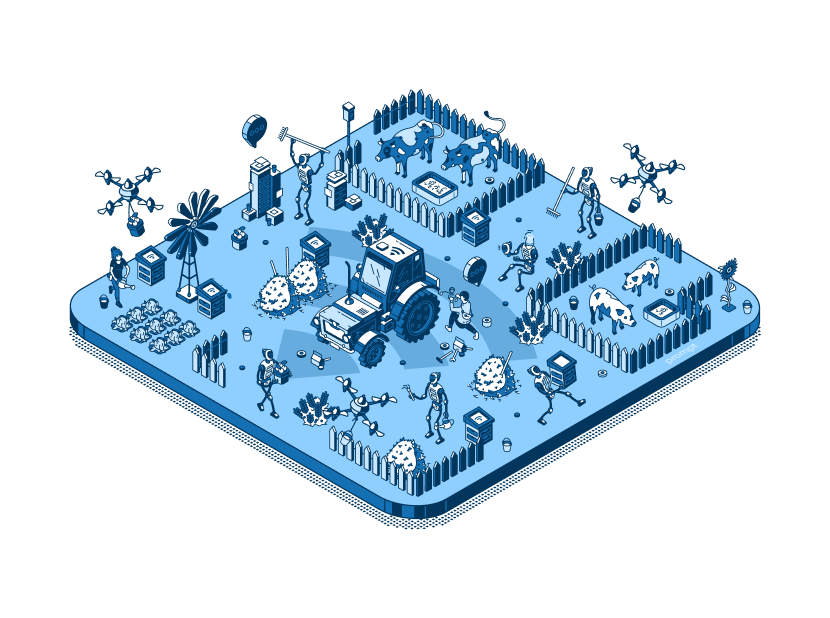Today, farmers are facing more pressure than ever before. Demand for food is growing as the population increases, whereas agricultural land is used for urbanization. Not just this, the challenges caused by climate change are also decreasing the yield. Sometimes drought, sometimes flood, and unseasonal rain impact the total yearly yield, ultimately causing a shortage of food.
In the coming years, agricultural enterprises must operate in new and adapted ways to achieve sustainability and the capability to survive. The latest and most advanced technologies, falling under the roof of Smart Farming, provide opportunities for farmers to overcome unprecedented challenges while passing the agricultural way of life to future generations. This has led to a boost in the yield along with the profit.
Unfortunately, local farms, including some in the world’s most fertile lands, are also declining today. Therefore, creating a viable business is becoming challenging, and farmers must find ways to work more smartly instead of shedding sweat in the field.
Historically, agricultural structures demand immense amounts of time, money, and effort to order, unload, store, plant, monitor, cultivate, and harvest crops.
Advanced smart farming technologies provide new methods to simplify the workflow and enhance operations, leading to robust businesses.
IoT’s Shining Agricultural Future
The Internet of Things (IoT) is the soul of this transformation process. Intelligent sensors are implanted throughout a farm that behaves like the eyes and ears of the farmers. It collects information about crops, the equipment’s condition, and performance. One of IoT technology’s most crucial characteristics is its ability to expand visibility to new endpoints. IoT empowers farmers with real-time monitoring and analytics systems through which they gain more insights into their operations and the capability to handle them more efficiently.
Let’s know some of the ways through which smart farming improves agricultural enterprises and will continue to do so in coming years:
1: Monitoring Crop Growth
IoT in the agriculture industry acts like a superhero; it assists farmers in improving the crop’s quality and the land’s fertility. Sensors integrated with IoT systems collect nutrient density information, allowing farmers to adjust the amount of fertilizer to be used. If any symptoms of infestation are observed, using pesticides can eliminate the invasion. In actuality, data-driven agriculture always empowers farmers because the information received permits adjusting activities imaging the current conditions, handling the crop cycle more effectively, achieving efficiency, and enhancing crop growth.
2: Improving Greenhouse Operations
Greenhouse IoT sensors improve visibility and automate traditional manual functions, making the entire process more efficient and automated. They gather and transfer real-time data, like air pressure, humidity, temperature, soil conditions, and light levels. In fact, water consumption can be managed with SMS or email alerts if any defects occur. In modified systems, adjustments are made automatically. The processes turn out to be more cost-effective and accurate, and operational performance improves.
3: Tracking Water consumption
Agricultural IoT supports farmers in monitoring water tank levels in real time by tracking the amount of water being used and the amount of water left in the tank. Smartphones provide intuitive reports that analyze trends and make recommendations in many cases. Farmers can alter water usage as needed, making irrigation more efficient and economical.
Predictive Equipment Maintenance
Farmers can monitor their land, vehicles, and other assets through IoT. Farmers wish to reduce downtime as the equipment is essential to daily operations. It offers a clear view of the device’s performance, which updates as the equipment operates. Advanced data analytics provides them with the required management insights. Artificial Intelligence and machine learning measure an asset’s typical efficiency and wear and tear based on metrics like vibration analysis, oil analysis, and thermal imaging.
Predictive maintenance models depend on complicated algorithms to determine when an asset must be serviced, fixed, or retired. These insights come before the device stops performing. This assures that operations and processes at farms are continuous and seamless. The other advantages include lengthened machinery lifecycles, reduced downtime, and productive outcomes.
Smart Livestock Management
We all know that livestock management and monitoring demand good quality of time, effort, and money. Traditionally, employees are hired on farms to look after the health or injury of the cattle. The process is undoubtedly costly, highly unreliable, and inefficient.
IoT solutions terminate speculation when diagnosing an animal’s health by monitoring temperature, heart rate, blood pressure, etc. The information is sent through the wireless network to an application in real time.
Farmers can then access the mentioned information using mobile devices:
- Each animal’s health condition and location in its herds can be checked from anywhere at any time.
- Farmers can also check the peak mating time and season of the cattle.
- Farmers receive alerts if a metric falls outside of the normal range.
- Most suitable gazing spots can be easily determined.
Benefits to Agriculture and Personalized Services
By embracing smart farming technology, farmers can develop more suitable approaches, and this proficiency changes the relationship between customers and retailers. The farmers can emphasize consumers’ interest in sustainability and eco-friendly food while focusing on creating new strands of their products. They can then charge a premium for their products, enhance revenue and create a more substantial business.
Smart sensors automatically observe every facet of everyday agricultural work. This advanced technology allows farmers to automate real-time data collection, boost production volumes, cut down costs, reduce waste, and much more things that increase productivity. These many advantages are compelling farmers to spend on technology.
According to the worldwide smart farming review, investment in this field will increase from $3.715 billion in 2022 to $7.040 billion in 2026, a CAGR of 13.65 percent. It means farmers will have added hundreds of millions of IoT sensors to improve their everyday operations.
Steering Efficiency
Smart farming technology provides businesses with new ways to increase agricultural efficiency, reducing costs and boosting revenue. In other words, smart farming technology is most significant for the growth of modern farming, increasing the yield to meet growing demand and will keep agricultural industries viable in the future.

